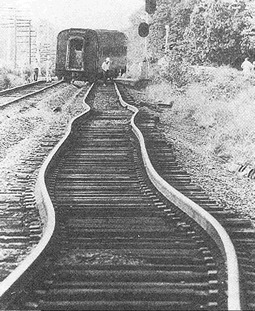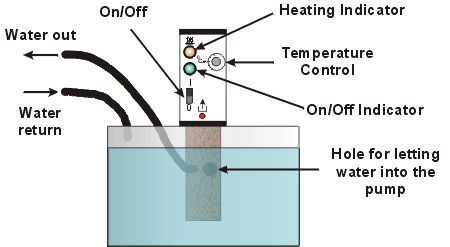This document introduces the Thermal Expansion Experiment from the Physics laboratory at the University of Toronto. It is intended to be used before you begin the experiment. The Preparatory Questions at the end of this document should be answered and turned in to your Demonstrator before you begin to work on the experiment.
![]()
In order to effectively use this page, your browser needs to be capable of viewing Flash animations, also known as swf files. The Flash player is available free from http://www.macromedia.com/. Our animations are for Version 5 of the player or later.
You will also want to have either the RealMedia or QuickTime video player installed on your computer. The RealMedia player is available free from http://www.realnetworks.com/. The QuickTime player is available free from http://www.apple.com/quicktime/.
A document of the soundtrack of the video and a summary of this page are also available below. They are in pdf format. Accessing these documents will require that you have the Acrobat Reader, which is available free from http://www.adobe.com
![]()
Most materials expand as they are heated and contract if they are cooled. Thus their length is a function of temperature. If the length of an object is L and the temperature changes by a differential amount dT, then the differential change in the length dL is given by:
where The photograph to the right shows railroad tracks distorted because of thermal expansion on a very hot July day. The photograph is from Halliday, Resnick and Walker, Fundamentals of Physics, 6th ed., Enhanced Problems Version, Figure 19-9 (Wiley, 2003), and is used by permission. |
 |
For small ranges of temperature, we can treat
![]() as a constant for a particular material; in the
experiment this is a reasonable approximation. You will determine
as a constant for a particular material; in the
experiment this is a reasonable approximation. You will determine
![]() for aluminum and copper.
for aluminum and copper.
| In the figure to the right we show an aluminum rod. The length of the rod is defined in the figure, and is similar but not identical to the definition you will use in the experiment. The rod is at a temperature T0 and has a length of L0. |
 |
In the figure, you can see a tab on the right-hand side of the rod, and we measure the length of the rod to the right-hand side of the tab. In the actual experiment there is a line inscribed on the top of the tab, and you will measure the length of the rod from the left-hand side to the line inscribed on the tab. Thus the lengths and changes in length of the rod shown in the figures are only similar to the actual definitions you will use in the experiment. |
|
| We heat the rod up to a temperature T > T0, and its length increases to L. |
 |
We shall call the change in temperature:
T
T - T0
and the corresponding change in length:
L
L - L0
Then if the product:
×
T
is small, Equation 1 becomes approximately:
| (2) |
You will use Equation 2 in the experiment.
You are supplied with two rods, made of aluminum and copper. Briefly, for each rod you will:
Getting from Equation 1 to Equation 2 involves solving the differential Equation 1, expanding the result in a Taylor series, and dropping higher order terms from the expansion. This sort of mathematical manipulation, which is part of theoretical physics, is what you are learning in the lecture component of your course. The laboratory is teaching the "better half" of physics: experimental physics.
![]()
We have prepared a video in various formats to introduce you to the apparatus; the running time of the video is about 4:10 minutes. Links to the video appear below. You will wish to adjust the volume of the speakers on your computer so that you can easily hear the soundtrack. For the higher resolution RealMedia version, you may also wish to increase the size of the video using the controls provided by the player.
| You may download a pdf version of the soundtrack of the video by clicking on the red button to the right. It will appear in a separate window, and has a file size of 59k. |
The Streaming video will be played by the RealMedia player as it is delivered to your computer by the network. The Download versions of the video will be downloaded to a temporary area on your local hard disc and then shown if your browser is configured to use the appropriate player. You may save these Download versions to a more permanent place that you specify on your computer's discs by right clicking on the link and then saving the Target (Internet Explorer) or Link (Netscape).
|
|||||||
|
|||||||
The figure to the right shows the part of the apparatus that heats the water and pumps it through the rod. Note that the level of water must be above the hole that lets water into the pump. You are supplied a pitcher with which you can add water if needed. |
 |
![]()
You will determine the coefficient of thermal expansion ![]() for the copper and the aluminum
tube. For each:
for the copper and the aluminum
tube. For each:
![]()
As promised, we have prepared a summary of the background information presented above. It does not attempt to provide a full discussion, but just reviews the "high points" from above.
You may access the summary by clicking on the green button to the right. The summary is in pdf format, will appear in separate window, and has a file size of 14k. You may wish to print this document. |
|
![]()
These questions should be answered and turned in to your Demonstrator before beginning the experiment. They replace the questions in the Guide Sheet for the experiment: if you are using this web-document as the introduction to the experiment you should answer these questions and not the ones in the Guide Sheet.
![]()
Earlier versions of the Guide Sheet for this experiment have been worked on by David Harrison (1983), Joe Vise (1988), Claude Plante (1993) and others.
This web version is by David M. Harrison, May 2003.
This is $Revision: 0.2 $, $Date: 2003/05/02 18:42:59 $ (y/m/d UTC).